Essential Guide to Small Outdoor Bird Cages
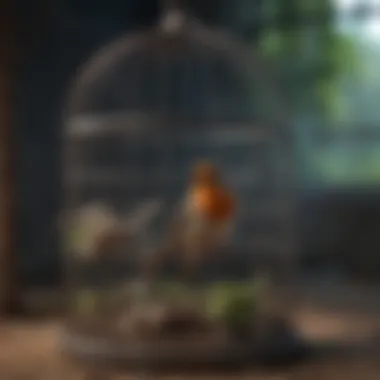
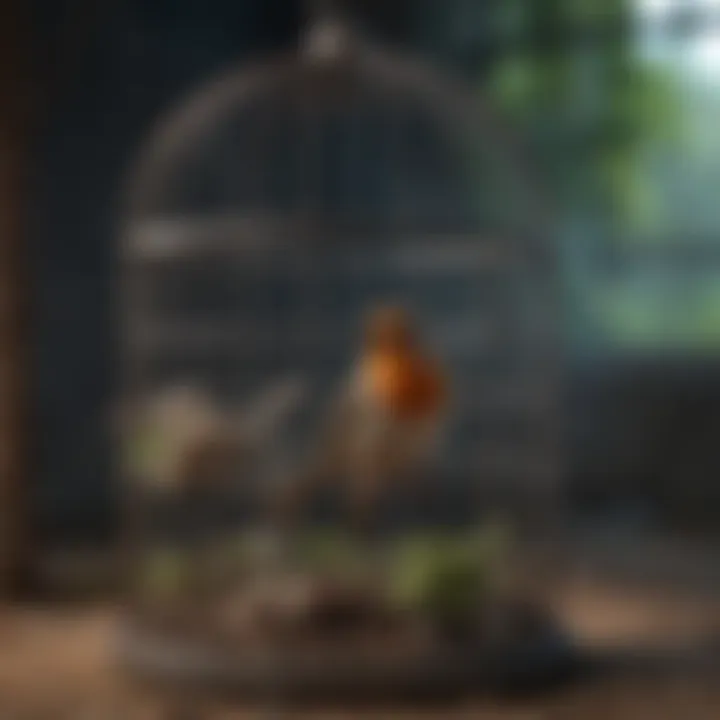
Intro
Creating a safe and comfortable environment for small birds is essential for their overall health. Bird cages designed for outdoor use must meet specific criteria to protect avian companions from the elements while ensuring their needs for space and activity are met. In this article, we will discuss the key considerations in choosing, maintaining, and enhancing small outdoor bird cages.
From materials to proper care and nutrition, this guide covers a range of important aspects. It is tailored to pet bird owners, aspiring bird parents, and bird breeders. Through examining best practices and core topics, bird enthusiasts will gain valuable insights for fostering a thriving habitat for their feathered friends.
Care Tips
Caring for birds in an outdoor setting involves more than just providing adequate space. Here, we explore essential routines, maintenance, hygiene practices, and necessary adjustments based on seasons.
Daily Care Routines
Everyday care is critical for the wellbeing of birds. Routine checks should include:
- Ensuring the feed and water are fresh.
- Observing the birds' behavior for signs of distress.
- Monitoring temperature and humidity to keep birds comfortable.
It can be helpful to create a checklist to ensure that no task is overlooked.
Cage Setup and Maintenance
When setting up an outdoor bird cage, the format and sturdiness are key. Choose ample room for birds to move. A typical layout should have:
- Multiple perches
- Designated feeding areas
- Safe corners to hide when needed
Feeding bowls and water containers must be secured to avoid spills. Additionally, consider using durable materials that resist weather conditions to prolong cage lifespan.
Hygiene and Cleaning Practices
Hygiene directly impacts bird health. Regularly cleaning the cage mitigate illnesses. Here are processes to factor:
- Empty and wash food and water containers daily.
- Replace or disinfect bedding once a week.
- Scrub cage surfaces using a pet-safe cleaner, ensuring no toxic residues are left.
Seasonal Care Adjustments
Birds may require different care based on the season. In summer months, their need for shade and water increases due to rising temperatures. For winter, providing insulation and avoiding drafts is essential. Between both extremes, consistently check conditions to match bird species needs, as some may be more tolerant than others.
Behavioral Insights
Understanding bird behavior fosters a strong bond between owners and their feathered partners. Recognizing typical bird body language can be enlightening.
Understanding Bird Body Language
Birds express feelings through body language. For instance, if a bird is puffed up, it may signify discomfort or cold. Understanding various postures provides insights into their emotional states.
Common Behavioral Issues and Solutions
Many birds display behavioral issues. Common problems include:
- Excessive squawking
- Feather plucking
- Lethargy
Each issue has a potential behavioral and environmental cure. Assess surroundings regularly and consider consulting avian professionals if symptoms persist.
Positive Reinforcement Techniques
Using rewards faster behavior can be highly effective. Treats, praise, and gentle interaction pave paths for bonding. Positive reinforcements can include:
- Favorite treats after specific behavior.
- Plenty of play and interaction directed towards the wanted behavior.
Social Interaction Needs
Birds thrive on interaction. They enjoy both human companionship and possibly that of other avian species. Engaging with them through play, light physical affection, or introducing toys can encourage their social habits, leading to cheerful birds.
Nutrition Guides
A bird's nutritional needs should not be ignored. Quality food is paramount to maintaining health.
Essential Diet Components
A balanced diet includes a mix of seeds, pellets, and fresh fruits or vegetables tailored to bird type. Ensure variety to avoid boredom and sustain health. Normal components for many types include:
- Pellets as primary food.
- Fresh greens like spinach or broccoli.
- Appropriate seeds based on species.
Safe and Toxic Foods
Not all foods suit avian species. Knowing safe vs toxic foods is crucial. Avoid items like chocolate, avocados, and caffeine, which can be fatal. Refer to groups and resources that specialize in avian diets for detailed charts.
Supplements and Treats
Occasional supplementation with vitamins can support fragile daily nutrition. Seasonal fruits and occasional protein sources like boiled eggs or insects can provide satisfying treats. Being cautious on portions is vital.
Feeding Strategies for Different Species
Different bird species have unique requirements. Research specific dietary needs thoroughly before introducing any changes to their meals. Every bird is distinct; therefore, a personalized approach is more beneficial.
Wellness and Health
Regular health checks can prevent significant failure in bird health.
Routine Health Checkups
Routine inspections should include checking feathers, examining claws, and monitoring weight. Recommended vet checkups to verify hormonal issues and physical anomalies are wise, even for healthy birds.
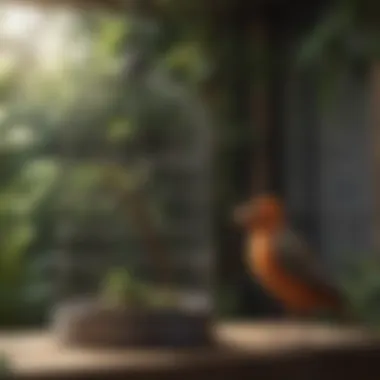
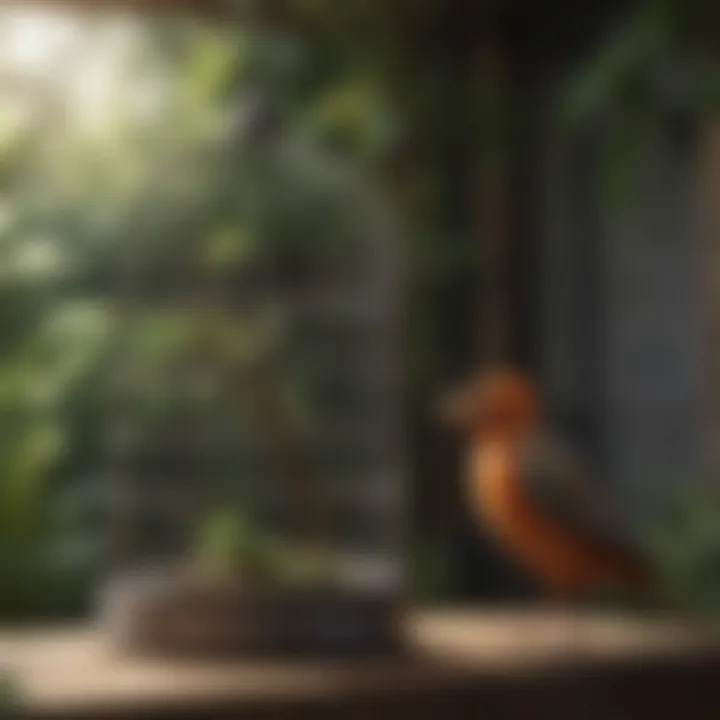
Identifying Symptoms of Illness
Birds may demonstrate symptoms subtly. For example, change in feathers or laying alone indicates potential health problems. Missing symptoms can turn serious quickly, so owners must stay attentive.
Preventative Care and Vaccinations
Preventing illness can include ensuring a proper diet as well as regular vet visits. Consider affiliation with veterinary resources to meet needs.
Mental and Emotional Well-being
Birds flourish with stable environments. Providing regular stimulation through interactions, new toys, and environmental changes supports emotional health.
Enriching Activities
Stimulating a bird's mind is advantageous. Moreover, activities can foster a friendly environment.
Toys and Playtime Ideas
Invest in diverse toys to keep birds engaged and physically active; swings, foraging toys, and bell-based toys serve great functions in stimulating activity.
Training and Tricks
Training bonds owners and their pets. Engage with simple commands using a calm voice and patience. Often positive result shall build trust and better relations.
Outdoor Activities and Interaction
Birds benefit outdoors as they take in fresh air and possibly forage. Supervised outings can prove both exciting and permissible. Just avoid exposure to significantly contagious wild birds and other pets.
DIY Projects for Mental Stimulation
Many bird toys can be constructed simply at home. Materials like cardboard, wood, and natural fibers should keep it safe. Building different implements supplies their need with greater value, held inside their habitats and for enrichment.
The End
Knowledge in caring for a small outdoor bird cage conveys whether a bird thrives or fails in terms of health. Focusing on essential daily care, understanding nature, nutrition, and behavioral habits will lead to flourishing avian companions. Staying informed is thus paramount for providing a quality home for beloved birds.
Prologue to Small Outdoor Bird Cages
Understanding the dynamics that come into play with small outdoor bird cages is fundamentally important for today's bird enthusiasts. Outdoor environments present unique challenges and advantages that necessitate careful consideration. With outdoor cages, owners must think about the safety, health, and well-being of their birds especially since these habitats differ vastly from indoor setups.
Outdoor spaces allow birds to experience natural sunlight, fresh air, and varied stimuli which are vital for their overall well-being. Birds benefit from exposure to common elements found in nature, such as sunlight, wind, and the sounds and sights of nearby wildlife. These aspects can significantly improve their mental and physical health, creating a more enriching life. However, the correct selection of materials, the right design features, and adherence to safety measures are essential for creating a suitable outdoor environment.
Significance of Outdoor Spaces
Outdoor spaces hold particular significance for birds, influencing their behavior and vitality. The natural setting allows them to exhibit instinctive behaviors such as flapping, climbing, and exploring. Frequent exposure to these outdoor elements can enhance their skills and instincts. Moreover, the variance in temperature and weather conditions can simulate their natural habitat, further promoting their well-being.
However, simply placing a cage outdoors does not ensure that birds will thrive. It is crucial for bird owners to make sure these spaces are adequately secured against threats like predators. Predators, such as cats and raccoons, pose major dangers to unwatched birds, so considerations regarding cage placement and materials used in design play a significant role in ensuring a safe environment.
Target Bird Species for Outdoor Caging
Certain species are more suited for outdoor housing than others due to their specific needs and temperaments. For instance, cockatiels, parakeets, and finches tend to adapt well to outdoor life given their playful, social nature and resilience to occasional weather variations.
However, those considering a small outdoor bird cage must research well. Some birds may experience extreme stress when outside under uncertain pressures or sounds. Others might be susceptible to temperature fluctuations. Species such as parrots and canaries require sensitive care, especially during harsh weather conditions. Selecting the correct bird species for outdoor caging not only ensures their comfort but also limits potential issues that arise from inadequate living conditions. The responsible bird owner thoroughly investigates each species, weighing their strengths and weaknesses in an outdoor environment.
Understanding both the benefits and challenges of different species informs better decisions in selecting and sourcing values in bird care.
Choosing the Right Material
Selecting the right material is a crucial factor when it comes to small outdoor bird cages. The material you choose influences the durability, safety, and overall effectiveness of the cage in welcoming your feathered companions. Each material offers distinct advantages that align with different needs and environments.
Metal vs.
Plastic Cages
When comparing metal and plastic cages, distinct characteristics become apparent.
Metal Cages
Metal cages, such as those made from stainless steel or powder-coated iron, are often preferred for their strength and longevity. They resist rust and provide a robust environment for birds. Protection against predators is enhanced, as metal grants more security than plastic. Cleaning and maintenance of metal cages is also typically easier due to their non-porous surfaces. They can withstand the rigors of the outdoors better than plastic counterparts.
However, one concern is the potential for heat retention, which can create temperatures incompatible with a bird's comfort. It's vital to observe how the metal cage reacts with local weather and direct sunlight exposure. Additional care in placing the cage in shaded areas can mitigate these issues.
Plastic Cages
Plastic cages present their own set of benefits. Lightwight and often available at lower prices, these cages are more portable. This aspect appeals to bird owners who frequently move their birds between locations. Nevertheless, plastic cages can be less durable and may fade or crack under prolonged UV exposure. Sometimes they can lack strength against possible predator attacks.
Weather Resistance Characteristics
Weather resistance is another pivotal factor influencing material selection for outdoor bird cages. The outdoor environment can be unpredictable. These conditions necessitate materials that maintain structural integrity under sun, rain, and fluctuating temperatures.
Metal cages often excel in this area, particularly when coated correctly to withstand corrosion from moisture. The use of weather-resistant paint or powder coating can significantly extend the life of metal cages and assert functional superiority in a rainy climate. Meanwhile, plastic cages must have UV stability to limit degradation under consistent sunlight.
A wise choice involves examining specifications provided by manufacturers regarding weather resistance. Features like appropriate coatings, materials designed for outdoor usage, and insulation options can impact the longevity and effectiveness of your cage outdoors. Style is important, yet functionality and protection against the elements must remain priority.
Overall, choosing the appropriate material in constructing an outdoor bird cage is essential. Consider the specific challenges and demands of your environment. Understanding the nuanced benefits and drawbacks can lead to a safer, more enjoyable habitat for your avian friends.
Design Features of Small Outdoor Bird Cages
Selecting the right design features for small outdoor bird cages is crucial for fostering the health and well-being of birds. Proper design can also enhance the bird cage's functionality, aesthetic appeal, and ease of maintenance. Each feature contributes to creating a balanced and enriching environment that suits the needs of different bird species while ensuring their safety.
Size and Space Considerations
When considering the size of an outdoor bird cage, the primary focus should be on the bird species that will reside in it. Different birds require varied levels of space for comfortable movement and display of natural behaviors. For instance, larger species like parrots need more room than smaller finches. It is essential to allocate sufficient space for the bird to stretch its wings and engage in physical activity. A crowded cage can lead to stress and even health issues, emphasizing the importance of proper sizing.
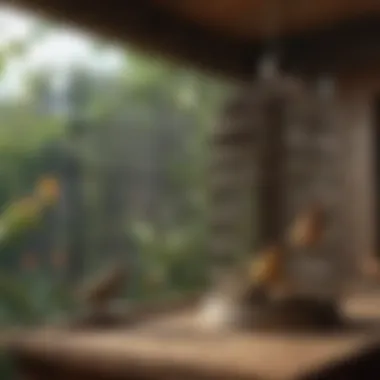
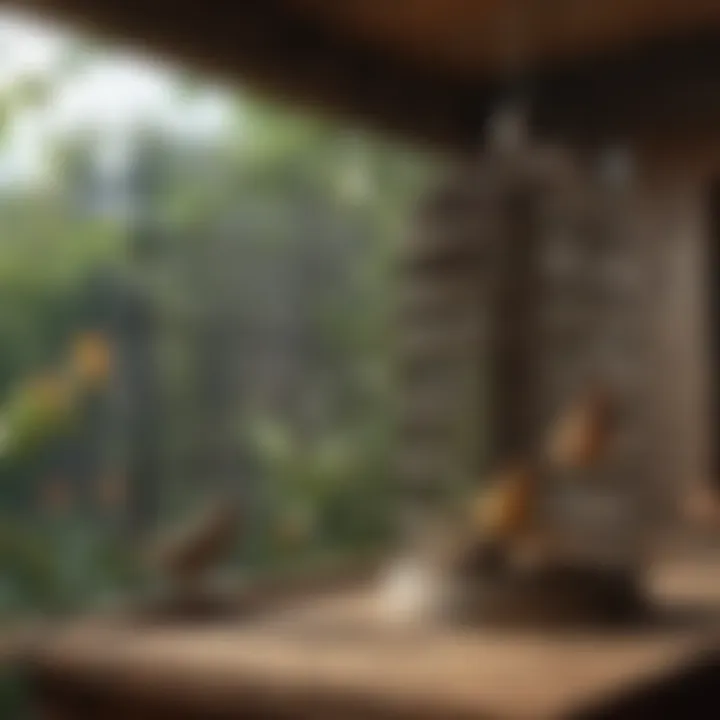
Furthermore, while choosing a cage, many owners overlook the trend that the height may be just as important as width. Some birds like to perch at different heights, mimicking their natural habitats. Therefore, a multi-level design can engage such birds more effectively.
- Some important size benchmarks include:
- Canaries typically thrive in cages around 24 inches long.
- Parakeets can do well in cages approximately 30-36 inches long and wide.
Flexibility in the space is equally important. Adjustable (removable) perches make it easier to create space for flying or playing. The right balance of size and organization encourages activity and cognitive enrichment for birds.
Ventilation and Sunlight Management
Ventilation stands as another key attribute in outdoor bird cage design. Ample airflow contributes to the overall health of birds. Stagnant air can encourage the growth of bacteria and mold, posing dangers to avian health. Design with openings and includes mesh panels to allow fresh air while keeping birds secure from potential predators. The spacing of the mesh should be chosen with care, ensuring it is safe and appropriate for the birds while maintaining airflow.
Direct sunlight should be taken into account in cage placement. Birds need a measure of sunlight for vitamin D synthesis, but too much can lead to overheating. Therefore, it is wise for owners to place cages in partial shade during peak points of sunlight throughout the day. With some strategic design features like positionable awnings or sunscreens, owners can take responsibility for managing light exposure effectively.
Safety Features to Consider
Safeguarding birds from both internal and external threats is paramount. Several features should be integrated for ensuring their protection.
- A lockable door mechanism is essential to prevent accidental opening during interactions or particular incidents.
- Non-toxic materials should form the cage's structure. Oils or finishes that can release harmful fumes should be avoided to protect bird health. Likewise, unsecured spaces in cage designs will allow tiny creatures or critters access, risking predator attacks.
Other design considerations could include:
- Sturdy construction to withstand wind or adverse weather.
- Rounded corners and edges to prevent accidental injuries during attempted exits.
- Internal design elements promoting safety during movement, which may feature appropriately secured perches.
Whether the design leans towards a more minimalist approach or elaborate dimensions for aesthetic purposes, ensuring that each safety aspect is covered is critical. Birds are naturally curious, and their explorative demeanor should be supported safely.
Investing thoughtful attention into these design features yields a functional bird cage setup that resonates with both owner preferences and avian requirements. By keeping these elements in mind, the chances of ensuring a positive living environment surge significantly.
Placement of Outdoor Bird Cages
Choosing the right placement for an outdoor bird cage might seem straightforward, but it carries significant importance. The correct location can affect not only the bird's well-being but also its behavior and longevity. Proper site selection mitigates potential stressors while creating a harmonious environment that can benefit both the birds and their owners.
Ideal Location Selection
When selecting an ideal location for a small outdoor bird cage, it is essential to consider a few key elements:
- Sunlight Exposure: Understanding how much sunlight your chosen area receives each day is crucial. Birds need sunlight, but direct exposure during the hottest hours can be harmful. Partial shade, preferably with some dappled sunlight, is often ideal.
- Protection from Elements: The cage should be shielded from harsh weather conditions. Look for areas that block wind and provide cover from rain or snowfall. This protection not only helps the birds remain comfortable but also preserves the integrity of the cage materials.
- Visibility and Interaction: Birds benefit from being part of the family; placing the cage in a visible area encourages interactions. Locating it near your home allows for easy monitoring while the birds acclimates to their new surroundings.
- Safety from Predators: Always choose a location that minimizes the risk of predator access. Cats, hawks, and raccoons are all threats in outdoor environments. Elevating the cage or positioning it near non-climbable structures can improve safety.
These considerations ultimately work together, offering advantages that affect not only the bird's physical health but also its psychological welfare. Properly placed cages can encourage play, singing, and other healthy behaviors.
Seasonal Considerations
Appropriate placement can also vary with the changing seasons. Understanding seasonal impacts ensures that bird owners can adapt accordingly. Awareness of such factors can fortify a bird’s habitat by maximizing comfort and safety year-round.
- Summer: In hotter months, prioritize shaded areas, as extended direct sunlight can lead to overheating. Introducing a shady tree or an awning can create a cooler environment.
- Winter: Conversely, during colder months look for locations that shield the birds from freezing winds. Placing cages near structures or wrapping them in protective covers while ensuring proper ventilation can work well in these colder months.
- Rainfall Management: With varying amounts of rain in each season, ensure there is an appropriate drainage system in place. Avoid low areas where water can accumulate. Moveable cages can also allow for easier transition with the weather.
Adapting the cage's location as seasons change will help maintain an appropriate environment for your feathered friends, improving their overall health and happiness.
Always remember: The well-being of caged birds is closely tied to their environment. Regularly assess your condition to meet changing needs effectively.
Bird owners have a responsibility to ensure that the placement of the bird cage goes beyond mere convenience. Ideal locations contribute significantly to a thriving and vibrant birdhouse, setting a firm foundation for future bird-keeping success.
Nutrition and Enrichment for Birds
Proper nutrition and enrichment are crucial aspects for the health and well-being of birds kept in small outdoor cages. Access to a balanced diet and engaging activities significantly enhances their quality of life. Birds can thrive better when prepared with intentional care that considers their unique needs.
Feeding Practices in Outdoor Caging
When sourcing food for outdoor birds, it is essential to focus on high-quality birdseed mixes that cater to the specific species you own. Each type of bird has distinctive nutritional requirements that need to be considered. For instance, seed-eating birds such as budgerigars might require different nutrition compared to a fruit-eating parrot.
Some best practices include:
- Regular Feeding Schedule: Establishing consistent feeding routines can help maintain birds' health. It allows them to anticipate their meals and develop a good feeding habit.
- Fresh Produce: Incorporating fresh fruits and vegetables into their diet can ensure they receive necessary vitamins and nutrients. Spinach, carrots, and apples can be particularly appealing.
- Hydration: Proper hydration is vital, so ensure that clean, fresh water is always available.
- Portion Control: Monitor food consumption to prevent overfeeding, which can lead to obesity and related health issues.
The right feeding pratices ensure birds remain active and healthy in an outdoor setting, preventing dietary deficiencies and supporting their overall vitality. Picking appropriate food can make a substantial difference.
Toys and Enrichment Activities
To foster positive behavior and mental stimulation, incorporating toys and enrichment activities is very important. Birds possess relatively high intelligence levels and need varied stimuli to avoid boredom. Keep them entertained with engaging activities.
Here are some recommended enrichment activities:
- Variety of Toys: Rotate toys regularly to maintain interest. Swinging perches, shredders, and foraging toys can stimulate exploration.
- Interactive Elements: Provide opportunities for interaction. Some birds enjoy puzzles and can be trained using positive reinforcement methods.
- Natural Materials: Use items like branches and grasses for foraging activities. Not only does this mimic their natural habitats, but it also enriches their experience of adventure.
- Social Interaction: Spend daily time with your birds for social interaction, which is essential for their psychological welfare.
Engaging with your birds regularly improves their Eurochori status, leading to healthier and happier companions. Ensuring their lives encompass both physical and mental elements will discourage behaviors that result from confinement.
Daily Maintenance and Care
Daily maintenance and care are essential for the well-being of birds kept in small outdoor cages. Providing a clean and healthy environment encourages good behaviour and enhances your bird's quality of life. Neglecting maintenance routines may lead to health issues or an increase in stress levels for the birds.
Cleaning Protocols
Keeping the cage clean is a priority for any bird owner. A thorough cleaning schedule prevents disease and maintains hygiene. The cleanliness of the cage, food and water dishes has a direct impact on your bird's health.
Cleaning tasks should include:
- Daily: Remove old food, waste, and any uneaten seeds from the cage.
- Every few days: Rinse and scrub food and water containers with hot, soapy water. Ensure they are thoroughly rinsed afterward to eliminate any soap residue.
- Weekly: Disinfect the cage with a bird-safe cleaning solution. Scrub the surfaces, including perches, to remove urine and droppings effectively.
- Monthly: Take apart sections of the cage, if applicable, to clean thoroughly. Inspect for signs of wear and tear.
These cleaning protocols won't just keep the cage appealing. They'll also protect both the bird and the owners from potential health hazards. With consistent effort and attention, you can create an environment that is low in bacteria and safe for your pet.
Health Monitoring Practices
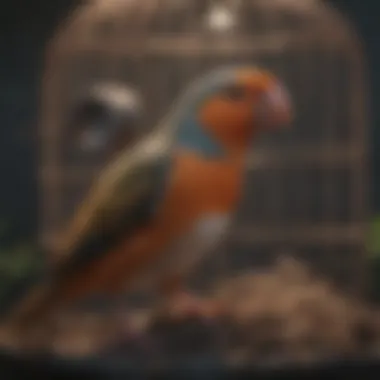
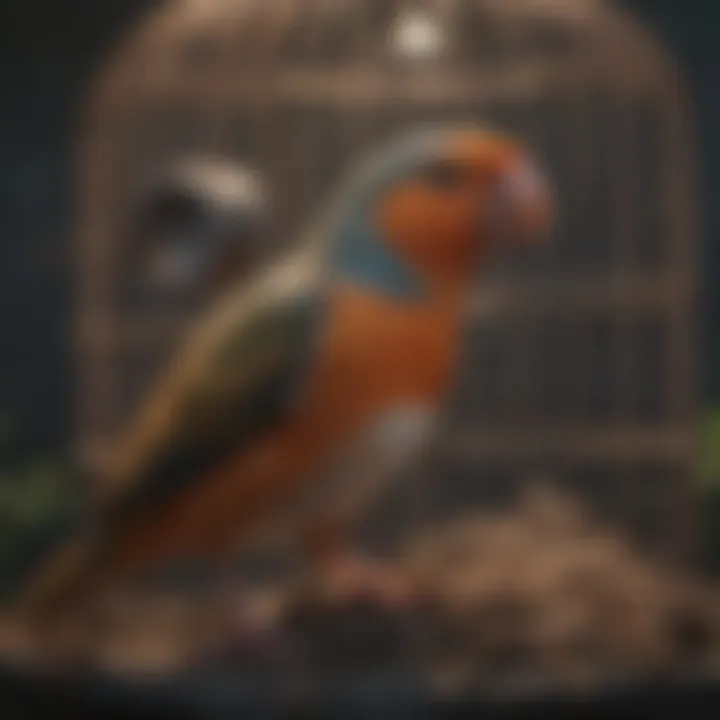
Health monitoring is crucial for every bird owner. Regular checks allow you to catch potential issues early, which is significant for outdoor environments where exposure can vary greatly. Assessing the condition of the bird should be an integral part of daily routines.
Key health indicators to observe include:
- Behavioural changes like excessive lethargy or changes in socialisation habits.
- Signs of distress, such as puffed-up feathers; they may indicate illness.
- Eating and drinking habits should remain consistent; reduced appetite may signal health concerns.
- Physical appearance, which includes irregularities in plumage, droppings, or weight loss.
Utilising a checklist can ensure that you remain vigilant in monitoring your pet's health. Concerning changes should prompt notifying a veterinarian. Regular attention will ensure your birds keep feeling content and their appearance remains healthy.
Ensuring cleanliness and proper health monitoring of outdoor cages will provide a safe haven for birds, free from potential diseases and distress.
Safety Precautions
Safety precautions are essential when caring for birds in outdoor cages. Outdoor environments introduce a unique set of challenges that can impact the well-being of your avian friend. A thorough understanding of safety protocols helps ensure a secure and healthy living space.
Second, securing an outdoor bird cage requires specific considerations. The primary concern is protecting birds from potential predators. Birds are instinctively prey, making them vulnerable to various animals such as cats, raccoons, and even birds of prey. Vigilance is required to choose a cage well-grounded against distress and escape avoidance.
Preventing these threats not only safeguards your bird but also contributes to a stress-free environment. Minimizing any unpredictable disturbances maintains the bird’s emotional health.
Another critical aspect relating to safety precautions is weather-related risks. Outdoor conditions vary greatly and can pose risks that deviate from those in an enclosed space. Extreme temperatures, heavy rain, and strong winds, for instance, can endanger a bird’s comfort and health. Awareness of local weather patterns and responding appropriately through proactive measures is important.
Ultimately, investing time in establishing a well-planned outdoor setup can save many problems on your bird's welfare and happiness.
Predator Protection Measures
Addressing the risk of predators is paramount when keeping birds outdoors. Consider the following steps to enhance security:
- Use predator-proof materials: Make sure that the cage is built with strong materials like stainless steel or heavy-duty plastic to withstand bites or scratches.
- Proper height or fencing: Elevate your cage off the ground or place it within a secure enclosure with fencing taller than common animals.
- Observational barriers: Utilize natural or artificial blindness while positioning the cage to minimize visible access from potential predator spots.
These steps collectively ensure a safer haven for your birds. Predators not only cause immediate harm but can also create long-term anxiety in birds if exposure occurs frequently.
Weather-Related Risks
Birds are sensitive to varying climatic conditions. Being aware of weather-related risks is essential for ensuring your avian friends remain comfortable and healthy. Some of the major risks include high temperatures, cold snaps, heavy rain, and strong gusts of wind.
- Temperature fluctuation considerations: During the summer, providing significant shade can help in preventing heat stress thirst and avoid danger signs like panting or lethargy. Conversely, insulation or housing with abundant bedding minimizes cold-related scrapingly during colder months.
- Rain protection: Ensure your water solutions do not lead to swimming hazards for smaller birds while offering coverage against precipitation proving damaging.
- Wind management: Position your cage in sheltered areas can minimize chaotic winds. Consistent observance of forecast is a recommended practice to set routine checks proactive to any high visibility forecasts.
Keeping your birds' surroundings controll under threat increase overall happiness for both your birds and competitiveness of providing safety needs. Monitor outdoor settings apply calm decision historic formats to manage risk prevention appropriately.
Prioritizing safety precautions allows avian companions to enjoy outdoor life yet under secure guideline practices. Agility is the most critical aspect in adopting healthy easy measures, assure that any barriers or controls targeted correlated delicacy observed regularly.
Legal Considerations for Outdoor Bird Cages
Understanding the legal framework surrounding outdoor bird cages is critical for bird owners. It ensures compliance with local ordinances, which not only affects the peace within the community but also promotes the well-being of the birds. Legal considerations include various facets such as regulations imposed by city or regional authorities, guidelines that govern animal welfare, and wildlife protections. Failure to adhere to these laws can result in fines, loss of birds, or other penalties. Therefore, it is significant to comprehend the rules that apply to keeping birds outdoors.
Regulations and Guidelines
When setting up a small outdoor bird cage, one must familiarize themselves with specific regulations and guidelines that exist. Many jurisdictions have distinct rules governing the housing of pet birds. These may dictate the type and size of the cage, the species that can be kept, and even requirements for physical barriers. For example, some areas may mandate a certain distance between bird cages and property lines or public areas. Breach of such regulations could lead to the removal of birds and imposition of fines. Within these frameworks, there is often an emphasis on ensuring the humane treatment of the birds to promote their health and safety. Reviewing local statutes, advice from bird specialists, or using reliable online databases, can help guide new bird owners through these complex landscapes.
Impact of Local Wildlife Laws
Local wildlife laws can have significant consequences on your ability to keep certain bird species outdoors. In many regions, there are laws protecting wildlife from being kept in captivity or those which prohibit the housing of native species. Certain birds, like the Northern Cardinal or American Robin, are protected by law and keeping them in a small outdoor bird cage may violate wildlife conservation policies.
Additionally, some regulations relate to potential interactions with wild birds or other fauna in the area. It is important to identify implications of letting caged birds interact with wild species. Interactions may result in the spread of disease, triggering local wildlife protection agencies to take action. Therefore, being aware of these local wildlife laws ensures the keeper acts responsibly, thus avoiding conflicts while providing a secure atmosphere for the birds.
Common Problems and Solutions
The theme of common problems and solutions holds significant value when considering the welfare of pet birds in outdoor cages. By understanding potential issues, bird owners can create a nurturing habitat that minimizes distress and enhances the quality of life for their avian companions. Recognizing behavioral challenges and health concerns can inform effective management strategies, ensuring the safety and happiness of your birds. Through addressing these challenges, you commit not only to the lifelong care but also to the emotional requirements of your birds.
Addressing Behavioral Issues
Birds, particularly in outdoor cages, may exhibit behaviors that signal discomfort or stress. Common behavioral issues include excessive screeching, feather plucking, or listless behavior. Such actions often arise because of environmental stressors or insufficient mental stimulus. Here are some elements to consider to address these concerns:
- Environmental Enrichment: Provide diverse toys and social interaction. Rotate toys regularly to keep your birds engaged. Opt for materials they can chew or manipulate to satisfy their natural instincts.
- Consistency and Routine: Birds thrive on predictability. Set feeding times and maintenence schedules that align with their natural instincts. It helps them feel secure in their surroundings.
- Observation: Spend time observing your birds, watching for minute changes in behavior or signs of distress. Early comprehension of a change can lead to timely intervention.
Dealing with behavioral issues requires an ongoing commitment to understanding and observing your feathered friends, thereby allowing you to adapt your approach as their needs evolve.
Resolving Health Concerns
Health concerns are particularly worrisome for outdoor birds, as they can face greater environmental risk factors. Regular health assessments are imperative. Owners should remain vigilant in observing changes in their bird's physical condition. Here are important considerations regarding health:
- Regular Vet Check-Ups: Schedule routine visits as a preventative measure. Many health issues can be treated effectively when identified early.
- Round-the-Clock Monitoring: Keep an eye out for signs of distress such as changes in appetite, difficulty flying, or unusual droppings. Acting swiftly can make a significant difference.
- Maintain Clean Habitat: Regularly clean the cage to avoid disease transmission from droppings or uneaten food. Establish a pro-active cleaning protocol.
Advocating for proper bird health helps ensure a longer lifespan and a higher quality of life. Your dedication to identifying and resolving these health concerns bears fruits in the mutual bond shared with your feathered friends.
Acknowledging and proactively addressing these possible behavioral and health challenges can build a more harmonious environment, ultimately leading to flourishing well-being and happiness for your birds.
Culmination
The conclusion serves as an opportunity to reflect on the fundamental aspects of maintaining and using small outdoor bird cages. Recognizing the dynamics of the outdoor environment is critical for the well-being of birds and their owners. Addressing several essential elements not only affirms a commitment to responsible birdkeeping but also ensures the creatures thrive in their abode.
Recap of Key Points
Decisively, this article navigated vital topics associated with small outdoor bird cages. Here are the key points derived from the elaboration:
- Material Selection: Importance of choosing weather-resistant materials when constructing or selecting a cage.
- Design Considerations: Emphasized space requirements, ventilation needs, and safety features.
- Placement and Environment: Suggested ideal locations ensuring sunlight, wind conditions, and protection from predators.
- Nutritional Aspect: Discussed appropriate feeding practices and the necessity of enrichment to meet individual bird needs.
- Maintenance Protocol: Outlined regular cleaning and health monitoring strategies crucial for wellbeing.
- Legal Figure Out: Addressed key legal guidelines that relate to outdoor bird cages.
By reviewing these concepts, one can grasp how they fit into the practical aspects of caring for avian companions outdoors. Each element discussed directly contributes to creating a safe, nuturing evvironment for pet birds.
Encouragement for Responsible Birdkeeping
Encouraging responsible birdkeeping implies an acknowledgment of both the privileges and challenges involved in nurturing birds as companions. The pursuit of understanding small outdoor bird cages intersects with ethical and practical responsibilities.
Bird owners must stay informed about the specific requirments for their bird species, particularly how they interact socially and their need for outdoor exposure. Creating a positive outdoor habitat has froven beneficial, providing stimulation and that natural sunlight while maintaining safe conditions. Regular assessment of birds and cage setups will be rewarding in maintaining consistent health, behavior, and well-being.
To cement the practice of responsible birdkeeping:
- Stay Informed: Read literature and journals concerning caring for birds in various atmospheres.
- Connect with Fellow Owners: Utilize platforms like Reddit or Facebook groups to share experiences and gather advice.
- Keep Enrichment in Mind: Providing varying experiences promotes mental and physical engagement for birds.
In sum, becoming adept in these practices enhances not only the life of birds but equally fortifies the bond between birds and their caretakers.















